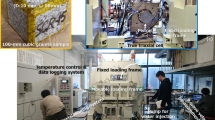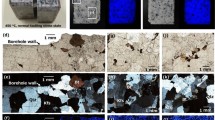Abstract
Superhot geothermal environments with temperatures of approximately 400–500 °C at depths of approximately 2–4 km are attracting attention as new kind of geothermal resource. In order to effectively exploit the superhot geothermal resource through the creation of enhanced geothermal systems (superhot EGSs), hydraulic fracturing is a promising technique. Laboratory-scale hydraulic fracturing experiments of granite have recently demonstrated the formation of a dense network of permeable fractures throughout the entire rock body, referred to as a cloud-fracture network, at or near the supercritical temperature for water. Although the process has been presumed to involve continuous infiltration of low-viscosity water into preexisting microfractures followed by creation and merger of the subsequent fractures, a plausible criterion for cloud-fracture network formation is yet to be clarified. The applicability of the Griffith failure criterion is supported by hydraulic fracturing experiments with acoustic emission measurements of granite at 400 °C under true triaxial stress and at 450 °C under conventional triaxial stress. The present study provides, for the first time, a theoretical basis required to establish the procedure for hydraulic fracturing in the superhot EGS.

adapted from Watanabe et al. (2019)















Similar content being viewed by others
Abbreviations
- P b :
-
Breakdown pressure
- P p :
-
Pore pressure
- P p, frac :
-
Pore pressure required for fracturing/failure
- σ1 :
-
Maximum principal stress
- σ2 :
-
Intermediate principal stress
- σ3 :
-
Minimum principal stress
- σh :
-
Minimum horizontal stress
- σH :
-
Maximum horizontal stress
- σt :
-
Tensile strength
- σv :
-
Vertical stress
- v p 1 :
-
P-wave velocity for a voxel 1 assigned within a rock sample
- v p 2 :
-
P-wave velocity for a voxel 2 assigned within a rock sample
- v p 3 :
-
P-wave velocity for a voxel 3 assigned within a rock sample
- V p :
-
P-wave velocity defined as 1/Vp = (1/vp1 + 1/vp2 + 1/vp3)/3
References
Batini, F., Bertini, G., Bottai, A., Burgassi, P., Cappetti, G., Gianelli, G. & Puxeddu, M. San Pompeo 2 deep well: a high temperature and high pressure geothermal system. In: Strub, A., Ungemach, P., editors. European geothermal update: Proceedings of the 3rd international seminar on the results of EC geothermal energy research, pp. 341–353 (1983).
Baron G, Ungemach P (1981) European geothermal drilling experience-problem areas and case studies. In: International geothermal drilling and completions technology conference. Albuquerque, NM, USA. p. 24
Griffith AA (1924) Theory of rupture. In: Proceedings of the First International Congress on Applied Mechanics. In: CB Biezeno, JM Burgers(eds), pp. 55–63. J Waltman, Delft
Chaki S, Takarli M, Agbodjan WP (2008) Influence of thermal damage on physical properties of a granite rock: Porosity, permeability and ultrasonic wave evolutions. Constr Build Mater 22:1456–1461
Chen Y, Nishiyama T, Ito T (2001) Application of image analysis to observe microstructure in sandstone and granite. Resour Geol 51:249–258
Chen Y (2008) Observation of microcracks patterns in Westerly granite specimens stressed immediately before failure by uniaxial compressive loading. Chin J Rock Mech Eng 27:2440–2448
Chen Y, Nagaya Y, Ishida T (2015) Observations of fractures induced by hydraulic fracturing in anisotropic granite. Rock Mech Rock Eng 48(4):1455–1461
Chen Y, Watanabe K, Kusuda H, Kusaka E, Mabuchi M (2011) Crack growth in Westerly granite during a cyclic loading test. Eng Geol 117:189–197
Cox SF (2010) The application of failure mode diagrams for exploring the roles of fluid pressure and stress states in controlling styles of fracture-controlled permeability enhancement in faults and shear zones. Geofluids 10:217–233
Elders WA, Friðleifsson G, Albertsson A (2014) Drilling into magma and the implications of the Iceland Deep Drilling project (IDDP) for high-temperature geothermal systems worldwide. Geothermics 49:111–118
Espinosa-Paredes G, Garcia-Gutierrez A (2003) Estimation of static formation temperatures in geothermal wells. Energy Conv Manag 44(8):1343–1355
Fournier RO (1991) The transition from hydrostatic to greater than hydrostatic fluid pressure in presently active continental hydrothermal systems in crystalline rock. Geophys Res Lett 18(5):955–958
Fournier RO (1999) Hydrothermal processes related to movement of fluid from plastic into brittle rock in the magmatic-epithermal environment. Econ Geol 94(8):1193–1211
Frash LP, Gutierrez M, Hampton J, Hood J (2015) Laboratory simulation of binary and triple well EGS in large granite blocks using AE events for drilling guidance. Geothermics 55:1–15
Friðleifsson GO, Albertsson A, Stefansson B, Gunnlaugsson E, Adalsteinsson H (2007) Deep Unconventional Geothermal Resources: a major opportunity to harness new sources of sustainable energy. In: Proceedings, 20th World Energy Conference, Rome. World Energy Council, p. 21
Friðleifsson GO, Elders WA (2005) The Iceland Deep Drilling project: a search for deep unconventional geothermal resources. Geothermics 34:269–285
Friðleifsson GO, Elders WA, Albertsson A (2014) The concept of the Iceland deep drilling project. Geothermics 49:2–8
Friðleifsson GO, Elders WA (2017) The Iceland deep drilling project geothermal well at Reykjanes successfully reaches its supercritical target. Geotherm Resour Counc Bull 46:30–33
Garcia J, Hartline C, Walters M, Wright M, Rutqvist J, Dobson PF, Jeanne P (2016) The Northwest Geysers EGS demonstration project, California: Part 1: characterization and reservoir response to injection. Geothermics 63:97–119
Heuze FE (1983) High-temperature mechanical, physical and Thermal properties of granitic rocks—a review. Int J Rock Mech Min Sci Geomech Abstr 20(1):3–10
Jaeger JC, Cook NGW (1979) Fundamentals of rock mechanics, 3rd edn. Chapman & Hall, London
Hubbert MK, Willis DG (1957) Mechanics of hydraulic fracturing. Trans Am Inst Min Engrs 210:153–168
Kehle RO (1964) The determination of tectonic stresses through analysis of hydraulic well fracturing. J Geophys Res 69:259–273
Ingason K, Kristjánsson V, Einarsson K (2014) Design and development of the discharge system of IDDP-1. Geothermics 49:58–65
Ishida T, Chen Q, Mizuta Y, Roegiers J-C (2004) Influence of fluid viscosity on the hydrofracturing mechanism. J Energy Resour Technol 126:190–200
Ishida T, Aoyagi K, Niwa T, Chen Y, Murata S, Chen Q, Nakayama Y (2012) Acoustic emission monitoring of hydraulic fracturing laboratory experiment with supercritical and liquid CO2. Geophys Res Lett 39:L16309
Kato O, Doi N, Sakagawa Y, Uchida T (1998) Fracture systematics in and around well WD-1, Kakkonda geothermal field. Japan Geothermics 27(5–6):609–629
Luo J, Zhu Y, Guo Q, Tan L, Zhuang Y, Liu M, Zhang C, Zhu M, Xiang W (2018) Chemical stimulation on the hydraulic properties of artificially fractured granite for enhanced geothermal system. Energy 142:754–764
Ma Y, Li S, Zhang L, Liu S, Liu Z, Li H, Shi E (2020) Study on the effect of well layout schemes and fracture parameters on the heat extraction performance of enhanced geothermal system in fractured reservoir. Energy 202:117811
Moore DE, Lockner DA, Byerlee JD (1994) Reduction of permeability in granite at elevated temperatures. Science 265:1558–1561
Morrow CA, Moore DE, Lockner DA (2001) Permeability reduction in granite under hydrothermal conditions. J Geophys Res 106:30551–30560
Nishiyama T, Kusuda H (1994) Identification of pore spaces and micro cracks using fluorescent resins. Int J Rock Mech Min Sci Geomech Abstr 31:369–375
Nishiyama T, Chen Y, Kusuda H, Ito T, Kaneko K, Kita H, Sato T (2002) The examination of fracturing process subjected to triaxial compression test in Inada granite. Eng Geol 66:257–269
Parisio F, Vinciguerra S, Kolditz O, Nagel T (2019) The brittle-ductile transition in active volcanoes. Sci Rep 9(1):1–10
Reinsch T, Dobson P, Asanuma H, Huenges E, Poletto F, Sanjuan B (2017) Utilizing supercritical geothermal systems: a review of past ventures and ongoing research activities. Geothermal Energy 5:16
Ruggieri, G. & Gianelli, G. Fluid inclusion data from the Carboli 11 well, Larderello geothermal field, Italy. In: World Geothermal Congress, Italy; pp. 1087–1091 (1995).
Saishu H, Okamoto A, Tsuchiya N (2014) The significance of silica precipitation on the formation of the permeable-impermeable boundary within earth’s crust. Terra Nova 26(4):253–259
Secor DT (1965) Role of fluid pressure in jointing. Am J Sci 263:633–646
Steingrimsson B, Gudmundsson A, Franzson H, Gunnlaugsson E (1990) Evidence of a supercritical fluid at depth in the Nesjavellir field. In: Proceedings, 15th Workshop on Geothermal Reservoir Engineering. Stanford: Stanford University, p. 8
Smith R, Shaw H (1975) Igneous-related geothermal systems. In: D. White, D.Williams (eds) Assessment of geothermal resources of the United States—1975. U.S. Geological Survey Circular 726, 58–83 (1975).
Smith R, Shaw H (1979) Igneous-related geothermal systems. In: L. Muffler (eds). Assessment of geothermal resources of the United States, 1978. U.S. Geological Survey Circular, vol 790, pp 12–17
Solberg P, Lockner D, Byerlee JD (1977) Shear and tension hydraulic fractures in low permeability rocks. Pure Appl Geophys 115:192–198
Solberg P, Lockner D, Byerlee JD (1980) Hydrofracturing in granite under geothermal conditions. Int J Rock Mech Min Sci Geomech Abstr 17:25–33
Tester JW, Anderson BJ, Batchelor AS, Blackwell DD, DiPippo R, Drake EM, Garnish J, Livesay B, Moore MC, Nichols K, Petty S, Toksöz MN, Veatch RW Jr (2006) The future of geothermal energy in the 21 century impact of enhanced geothermal systems (EGS) on the United States. MIT Press (MA), Cambridge
Tsuchiya N, Hirano N (2007) Chemical reaction diversity of geofluids revealed by hydrothermal experiments under sub- and supercritical states. Isl Arc 16(1):6–15
Tsuchiya N, Yamada R, Uno M (2016) Supercritical geothermal reservoir revealed by a granite-porphyry system. Geothermics 63:182–194
Tullis J, Yund RA (1977) Experimental deformation of dry Westerly granite. J Geophys Res 82:5705–5718
Violay M, Heap MJ, Acosta M, Madonna C (2017) Porosity evolution at the brittle-ductile transition in the continental crust: Implications for deep hydro-geothermal circulation. Sci Rep 7:7705
Watanabe N, Numakura T, Sakaguchi K, Saishu H, Okamoto A, Ingebritsen SE, Tsuchiya N (2017a) Potentially exploitable supercritical geothermal resources in the ductile crust. Nat Geosci 10(2):140–144
Watanabe N, Egawa M, Sakaguchi K, Ishibashi T, Tsuchiya N (2017b) Hydraulic fracturing and permeability enhancement in granite from subcritical/brittle to supercritical/ductile conditions. Geophys Res Lett 44:5468–5475
Watanabe, N., Sakaguchi, K., Goto, R., Miura, T., Yamane, K., Ishibashi, T., Chen, Y., Komai, T. & Tsuchiya, N. Cloud-fracture networks as a means of accessing superhot geothermal energy. Sci. Rep. 9, Article number: 939 (2019), licensed under CC BY 4.0.
Watanabe N, Saito K, Okamoto A, Nakamura K, Ishibashi T, Saishu H, Komai T, Tsuchiya N (2020) Stabilizing and enhancing permeability for sustainable and profitable energy extraction from superhot geothermal environments. Appl Energy 260:114306
Weis P, Driesner T, Heinrich CA (2012) Porphyry-copper ore shells form at stable pressure-temperature fronts within dynamic fluid plumes. Science 338:1613–1616
Zhang W, Guo T, Qu Z, Wang Z (2019) Research of fracture initiation and propagation in HDR fracturing under thermal stress from mesodamage perspective. Energy 178:508–521
Acknowledgements
The present study was supported in part by the Japan Society for the Promotion of Science (JSPS) through Grants-in-Aid for Scientific Research (B) (No. 17H03504), Challenging Research (Exploratory) (No. 18K19039), and JSPS Fellows (No. 20J2020108). The present study was also supported by JSPS and DFG under the Joint Research Program-LEAD (JRPs-LEAD with DFG) (No. JPJSJRP20181605). In addition, some results reported herein were obtained under a project commissioned by the New Energy and Industrial Technology Development Organization (NEDO). K.Y. was funded by the German Federal Ministry of Education and Research (BMBF) for the GeomInt project, Grant Number 03G0866A within the BMBF Geoscientific Research Program “Geo:N Geosciences for Sustainability”. F.P. was funded by the Deutsche Forschungsgemeinschaft (DFG, German Research Foundation): Project number PA 3451/1-1. The authors also would like to thank Toei Scientific Industrial Co., Ltd. for manufacturing the experimental system. The data that support the findings of the present study are available from the corresponding author upon reasonable request.
Author information
Authors and Affiliations
Corresponding author
Ethics declarations
Conflict of interest
The authors declare that they have no known competing financial interests or personal relationships that could have appeared to influence the work reported in this paper.
Additional information
Publisher's Note
Springer Nature remains neutral with regard to jurisdictional claims in published maps and institutional affiliations.
Rights and permissions
About this article
Cite this article
Goto, R., Watanabe, N., Sakaguchi, K. et al. Creating Cloud-Fracture Network by Flow-induced Microfracturing in Superhot Geothermal Environments. Rock Mech Rock Eng 54, 2959–2974 (2021). https://doi.org/10.1007/s00603-021-02416-z
Received:
Accepted:
Published:
Issue Date:
DOI: https://doi.org/10.1007/s00603-021-02416-z




